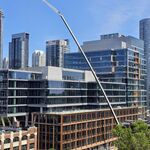GTS
Active Member
LA was not known for transit but in the last couple of decades they have invested a lot in public transit. They even have a bit of a subway, but most of their network is made up of different LRT lines and regional rail. I saw pictures of the LA LRT lines and they look like large trains that can carry a lot of passengers, like Calgary's C-Train or Edmonton's LRT. These LRT platform are even like a subway where you can roll across the platform and straight onto the LRT, this is handy for me as I have two children who need strollers for longer walks. When I search around on-line and look at different LRT systems around the world I am beginning to see that this is a mode of public transit that looks attractive enough to lure some of the fence sitters out of their cars and onto public transit and it won't break a city's bank account to build either.
One city that is close to here and has LRT is Buffalo. It is a small LRT line but hopefully that city expands it soon to serve some needed nodes of activity. I visited that city's transit system a few years ago when I first moved here from Vancouver. It is a small system and I hope that city expands it.
I don't know if Toronto should invest in Low-floor LRT when the other systems that I have visited and read about are accessible without being low-floor. One item that I hope they adress for the Sheppard line is station spacing. The buses serve the area well, although crush loaded at times, and if the route becomes LRT some of these used bus stops won't have an LRT station near them. I hope the TTC doesn't lose riders because of this. Also I my family and I have an important friend who can't walk far, he is dependent on buses, uses them daily, but would not be able to walk far to an LRT station. He has lived at the same address for a few years now and can't afford to move and he is kind of set in his ways as well. I hope Transit City helps more people then it harms- their will always be someone who loses though even if every other person it TO had subway station at their doorstep.
One city that is close to here and has LRT is Buffalo. It is a small LRT line but hopefully that city expands it soon to serve some needed nodes of activity. I visited that city's transit system a few years ago when I first moved here from Vancouver. It is a small system and I hope that city expands it.
I don't know if Toronto should invest in Low-floor LRT when the other systems that I have visited and read about are accessible without being low-floor. One item that I hope they adress for the Sheppard line is station spacing. The buses serve the area well, although crush loaded at times, and if the route becomes LRT some of these used bus stops won't have an LRT station near them. I hope the TTC doesn't lose riders because of this. Also I my family and I have an important friend who can't walk far, he is dependent on buses, uses them daily, but would not be able to walk far to an LRT station. He has lived at the same address for a few years now and can't afford to move and he is kind of set in his ways as well. I hope Transit City helps more people then it harms- their will always be someone who loses though even if every other person it TO had subway station at their doorstep.




